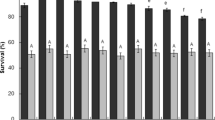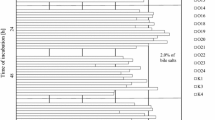Abstract
Lactic acid bacteria from indigenous pickled vegetables and fermented beverages (fermented rice and Madhuca longifolia flowers) were isolated and investigated for their functional characteristics in vitro as potential new probiotic strains. Four isolates (all Lactobacillus spp.) selected on the basis of high tolerance to bile (0.2%) were identified by standard and molecular methods (16S rDNA) as L. helveticus, L. casei, L. delbrueckii and L. bulgaricus from pickled vegetables and fermented beverages respectively. These selected strains had antibiotic resistance, tolerance to artificial gastric juice and phenol (0.4%), enzymatic profile, and antagonistic activity against enteric pathogens (Enterobacter sakazakii, Salmonella typhimurium, Shigella flexneri 2a, Listeria monocytogenes, Yersinia enterocolitica and Aeromonas hydrophila). All strains survived well in artificial gastric juice at low pH (3.0) values for 4 h, possessed bile salt hydrolase activity and were susceptible to most antibiotics including vancomycin. Additionally, the isolates exhibited high tolerance to phenol, high cell surface hydrophobicity (>60%) and induced proliferation of murine splenocytes. All the four strains of present study suppressed the Con A-stimulated proliferation of the mouse spleen cells, although L. casei had the strongest suppressive effect. The results of this study suggest a potential application of the strains (following human clinical trials), for developing probiotic foods.

Similar content being viewed by others
References
Battcock M, Azam-Ali S (1998) Fermented fruits and vegetables, a global perspective. FAO Agricultural Services Bulletin No. 134, Food and Agriculture Organization of the U.N., Rome. ISBN: 92-5-104226-8
Casey PG, Casey GD, Gardiner GE, Tangney M, Stanton C, Ross RP, Hill C, Fitzgerald GF (2004) Isolation and characterization of anti-Salmonella lactic acid bacteria from the porcine gastrointestinal tract. Lett Appl Microbiol 39:431–438
Chesson A, Franklin A, Aumaître A, Sköld O, Leclercq R, von Wright A, Guillot JF (2002) Opinion of the scientific committee on animal nutrition on the criteria for assessing the safety of microorganisms resistant to antibiotics of human and veterinary importance. Directorate C-Scientific Opinions. European Commission Health and Consumer Protection Directorate-General, Brussels
Choi CW, Park MH, Hwang SH, Woo SG, Song MK, Im JJ, Hong SG, Kim JH (2003) Novel microorganism Pediococcus pentosaceus EROM 101, having immune enhancement, anticancer and antimicrobial activities. Free patents online (http://www.freepatentsonline.com/20050131288.html)
Chou LS, Weimer B (1999) Isolation and characterization of acid- and bile-tolerant isolates from strains of Lactobacillus acidophilus. J Dairy Sci 82:23–31
Cole CB, Fuller R, Carter SM (1989) Effect of probiotic supplements of Lactobacillus acidophilus and Bifidobacterium adolescentis on β-glucosidase and β-glucuronidase activity in the lower gut of rats associated with a human faecal flora. Microb Ecol Health Dis 2:223–225
Coppola R, Succi M, Tremonte P, Reale A, Salzano G, Sorrentino E (2005) Antibiotic susceptibility of L. rhamnosus strains isolated from Parmigiano Reggiano cheese. Lait 85:193–204
De Boever P, Wouters R, Verschaeve L, Berckmans P, Schoeters G, Verstraete W (2000) Protective effect of the bile salt hydrolase-active Lactobacillus reuteri against bile salt cytotoxicity. Appl Microbiol Biotechnol 53:709–714
De Smet I, Van Hoorde L, Vande Woestyne M, Christianes H, Verstraete W (1995) Significance of bile salt hydrolytic activities of lactobacilli. J Appl Microbiol 79:292–301
Du Toit M, Franz CMAP, Dicks LMT, Schillinger U, Haberer P, Warlies B, Ahrens F, Holzapfel WH (1998) Characterisation and selection of probiotic lactobacilli for a preliminary minipig feeding trial and their effect on serum cholesterol levels, faeces pH, and faeces moisture content. Int J Food Microbiol 40:93–104
Fernández MF, Boris S, Barbés C (2003) Probiotic properties of human lactobacilli strains to be used in the gastrointestinal tract. J Appl Microbiol 94:449–455
Franz C, Specht I, Haberer P, Holzapfel WH (2001) Bile salt hydrolase activity of enterococci isolated from food: screening and quantitative determination. J Food Prot 64:725–729
Gill HSKJ, Rutherfurd JP, Gopal PK (2000) Enhancement of natural and acquired immunity by Lactobacillus rhamnosus (HN001), Lactobacillus acidophilus (HN017) and Bifidobacterium lactis (HN019). Br J Nutr 83:167–176
Grill JP, Perrin S, Scheneider F (2000) Bile salt toxicity to some bifidobacteria strains: role of conjugated bile salt hydrolase and pH. Can J Microbiol 46:878–884
Halami PM, Chandrashekar A, Nand K (2000) Lactobacillus farciminis MD, a newer strain with potential for bacteriocin and antibiotic assay. Lett Appl Microbiol 30:197–202
He X, Lux R, Kuramitsu HK, Anderson MH, Shi W (2009) Achieving probiotic effects via modulating oral microbial ecology. Adv Dent Res 21:53–56
Heilig HGHJ, Zoetendal EG, Vaughan EE, Marteau P, Akkermans ADL, de vos VW (2002) Molecular diversity of Lactobacillus spp. and other lactic acid bacteria in the human intestine as determined by specific amplification of 16S ribosomal DNA. Appl Environ Microbiol 68:114–123
Hofmann A (1991) Enterohepatic circulation of bile acids. In: Schultz SG, Forte JG, Rauner BB (eds) Handbook of physiology. Section 6: the gastrointestinal system, vol 3, pp 567–580
Jin LZ, Ho YW, Ali MA, Abdullah N, Jalaludin S (1996) Effect of adherent Lactobacillus spp. on in vitro adherence of Salmonella to the intestinal epithelial cells of chicken. J Appl Bacteriol 81:201–206
Kim EJ, Young YJ, Kang SJ, Chang SY, Huh K, Nam DH (2001) Molecular discrimination of Cervidae Antlers and Rangifer Antlers. J Biochem Mol Biol 34:114–117
Knorr D (1998) Technology aspects related to microorganisms in functional foods. Trends Food Sci Technol 9:295–306
Kociubinsky G, Pérez P, De Antoni G (1999) Screening of bile resistance and bile precipitation in lactic acid bacteria and bifidobacteria. J Food Prot 62:905–912
Kostinek M, Pukall R, Rooney AP, Schillinger U, Hertel C, Charles HHW (2005) Lactobacillus arizonensis is a later heterotypic synonym of Lactobacillus plantarum. Int J Syst Evol Microbiol 55:2485–2489
Lee YK, Salminen S (1995) The coming age of probiotics. Trends Food Sci Technol 6:241–245
Lee K, Jang SJ, Lee HJ, Ryoo N, Kim M, Hong SG, Chong Y (2004) Increasing prevalence of vancomycin-resistant Enterococcus faecium, expanded-spectrum cephalosporin-resistant Klebsiella pneumoniae, and imipenem-resistant Pseudomonas aeruginosa in Korea: KONSAR study in 2001. J Korean Med Sci 19:8–14
Mann GV (1974) Studies of a surfactant and cholesteremia in the Maasai. Am J Clin Nutr 27:464–469
Marshall VM (1979) A note on screening hydrogen peroxide-producing lactic acid bacteria using a non-toxic chromogen. J Appl Bacteriol 47:327–328
Marteau P, Minekus M, Havenaar R, Huis In’t Veld JHJ (1997) Survival of lactic acid bacteria in a dynamic model of the stomach and small intestine: validation and the effects of bile. J Dairy Sci 80:1031–1037
Matsuzaki T, Chin J (2000) Modulating immune responses with probiotic bacteria. Immunol Cell Biol 78:67–73
Mourad K, Nour-Eddine K (2006) In vitro preselection criteria for probiotic Lactobacillus plantarum strains of fermented olives origin. Int J Probiot Prebiot 1:27–32
Murosaki S, Muroyama K, Yamamoto Y, Kusaka H, Liu T, Yoshikai Y (1999) Immunopotentiating activity of nigerooligosaccharides for the T Helper 1-like immune response in mice. Biosci Biotech Biochem 63:373–378
Naidu AS, Bidlack WR, Clemens RA (1999) Probiotic spectra of lactic acid bacteria (LAB). Cri Rev Food Sci Nutr 38:13–126
Pérez Elortondo FJ, Albisu M, Barcina Y (1999) Physicochemical properties and secondary microflora variability in the manufacture and ripening of Idiazabal cheese. Lait 79:281–290
Ramadan MM, Tantawy EA, Shehata MS (2005) Effect of gamma rays on seed germination and seedling growth of some timber trees. Annals of Agric Sci Moshtohor 43:869–883
Reniero R, Cocconcelli P, Bottazzi V, Morelli L (1992) High frequency of conjugation in Lactobacillus mediated by an aggregation-promoting factor. J Gen Microbiol 138:763–768
Schiffrin EJ, Brassart D, Servin AL, Rochat F, Donnet-Hughes A (1997) Immune modulation of blood leukocytes in humans by lactic acid bacteria: criteria for strain selection. Am J Clin Nutr 66:515–520
Schillinger U, Lücke FK (1987) Identification of lactobacilli from meat and meat products. Food Microbiol 4:199–208
Shin HS, Huang EJ, Park BS, Sakai T (1999) The effects of seed inoculation on the rate of garbage composting. Environ Technol 20:293–300
Suskovic J, Brkic B, Matosic S, Maric V (1997) Lactobacillus acidophilus M 92 as potential probiotic strain. Milchwissenschaft 52:430–435
Tamang JP, Thapa N, Rai B, Thapa S, Yonzan H, Dewan S, Tamang B, Sharma R, Rai A, Chettri R (2007) Food consumption in Sikkim with special reference to traditional fermented foods and beverages: a micro-level survey. J Hill Res 20:1
Tannock GW, Dashkevitz MP, Feighner SD (1989) Lactobacilli and bile salt hydrolase in the murine intestinal tract. Appl Environ Microbiol 55:1848–1851
Uhlman L, Schillinger U, Rupnow JR, Holzapfel WH (1992) Identification and characterisation of two bacteriocin-producing strains of Lactococcus lactis isolated from vegetables. Int J Food Microbiol 16:141–151
Vescovo M, Torriani S, Dellaglio F, Bottazzi V (1993) Basic characteristics, ecology and application of Lactobacillus plantarum: a review. Annali di Microbiologia ed Enzimologia 43:261–284
Xanthopoulos V, Litopoulou-Tzanetaki E, Tzanetakis N (eds) (1997) In vitro study of Lactobacillus species strains on bile tolerance and cholesterol removal. In: Lactic acid bacteria—Lactic 97. Presses Universitaires de Caen, Caen
Zoetendal EG, Akkermans ADL, de Vos WM (1998) Temperature gradient gel host-specific communities of active bacteria. Appl Environ Microbiol 64:3854–3859
Acknowledgments
The authors thank the Director, Thapar University, Patiala for providing adequate infrastructure and Department of Biotechnology, Govt. of India for financial support.
Author information
Authors and Affiliations
Corresponding author
Rights and permissions
About this article
Cite this article
Kumar, M., Ghosh, M. & Ganguli, A. Mitogenic response and probiotic characteristics of lactic acid bacteria isolated from indigenously pickled vegetables and fermented beverages. World J Microbiol Biotechnol 28, 703–711 (2012). https://doi.org/10.1007/s11274-011-0866-4
Received:
Accepted:
Published:
Issue Date:
DOI: https://doi.org/10.1007/s11274-011-0866-4




